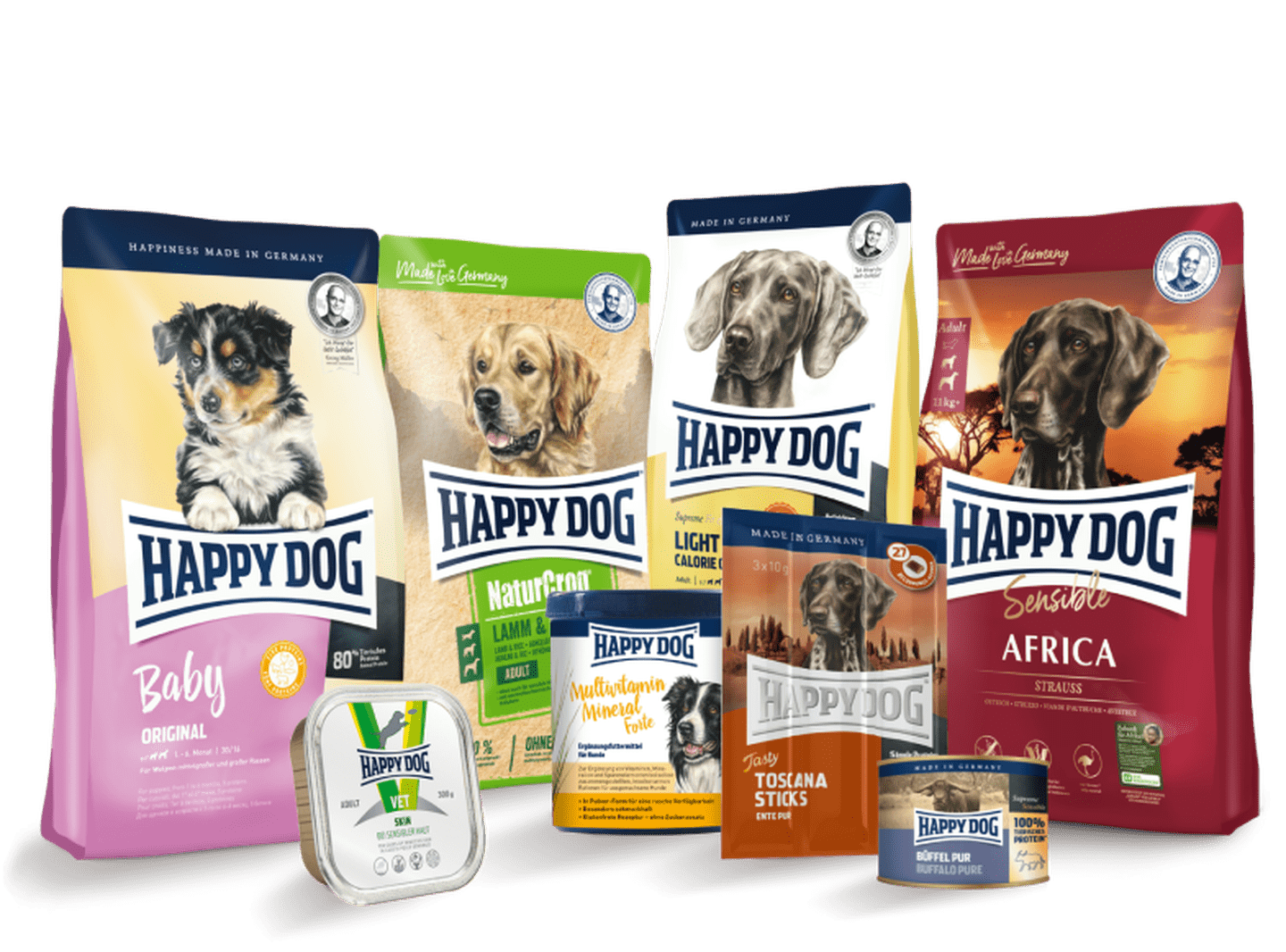All About the Ingredients in Your Dog’s Food
Share
Happy Dog vet, Carina Mederle, answers some commonly asked questions about the ingredients in your dog’s food. If you have any questions about dog food ingredients or nutrition for Carina, you can email support@happydoguk.com
Is Grain Harmful to Dogs?
The digestion of carbohydrates such as grain is generally not a problem for today’s dogs. The reasons of which are explained in a scientific study from Sweden (University of Uppsala), published in the January 2013 edition of Nature magazine. Over thousands of years, dogs have become more and more adapted to living with humans. Living off the leftovers of people, dogs have developed their ability to digest carbohydrates just as we evolved naturally from hunting to farming. So, for example, the enzyme required to break down starch is seven times more active in dogs than wolves according to the aforementioned study. Researchers have also found other evidence of dogs’ ability to process carbohydrates. That means there is no reason to make the general assumption that grain and other carbohydrates are unsuitable for use in dog food. It is more a matter of the animal’s individual tolerance, the quality of the grain used and how it was processed to make it digestible for the dog. Grain should only really be completely avoided if the dog has an allergy or intolerance to it. This is actually less common than you might think. If your dog seems unable to tolerate a number of different grains, then grain-free recipes - such as Happy Dog Supreme (Mini) Africa, Happy Dog Supreme Karibik and Happy Dog Supreme Canada - are the best option.What is the Meat Content of Your Dog's Food?
The term ‘meat ratio’ is unfortunately neither legally protected nor ‘scientifically’ determined. It is similar as with the word ‘light’, which (when talking about yoghurt, for example) can mean ‘reduced fat’, ‘low in calories’ or ‘light and fluffy.’ The most informative way to give information about meat contents is to define the ‘meat ratio’ as the amount of animal protein as a proportion of the crude protein in the whole feed formula. In the case of our Happy Dog Supreme varieties the ‘ratio of animal protein as a proportion of the total crude protein content’ is between 70% and 80% (excluding special recipes), depending on the feed formula used. It’s important to realize that a high-quality food is not only determined by a high amount of meat; more importantly is the use of a high-quality and therefore highly digestible meat.Why are Animal Protein Sources no Longer Described as ‘Meat Meal’ in Pet Food?
There are new legal regulations on the designation of feed materials originating from warm-blooded animals. What used to be called ‘poultry meat meal’ or ‘lamb meat meal,’ for example, must now be designated as ‘poultry meal’ or ‘lamb meal.’ Alternatively, it is also possible to call this raw ingredient ‘protein from poultry’ /‘poultry protein’ or ‘protein from lamb’ / ‘lamb protein,’ etc. As the designation ‘meal’ is so similar to ‘animal meal,’ despite the fact that it is a high-quality raw material derived from slaughtered animals which have been passed fit for human consumption. At Happy Dog we use the alternative term e.g. ‘poultry protein.’Why is Protein Diversity in Dog Food so Important?
In evolutionary history very few species have survived entirely on one food source. The reason: if adverse conditions cause the food source to fail, the animal is in grave danger of becoming extinct (for example as with pandas and bamboo food). Predators, in particular, have high requirements on their food as their lifestyle uses up a lot of energy. To ensure the survival it is essential to have access to as wide a variety of prey animals as possible. As well as covering the predator's basic requirements this also ensures an optimal variety of amino acids and fatty acids - even if one type of prey animal is unavailable. A varied and balanced diet is therefore ideal for preventing deficiencies, maintaining performance and ensuring an excellent physical constitution into a dog’s senior years.What’s the Best Way to Compare Dry Dog Food and Wet Dog Food?
As dry and wet food have significantly different water content, it is only possible to compare the nutrients contained in both types by measuring their ‘dry matter’ (DM), i.e. the quantities of nutrients in 100% dried form. Example: Comparison of the phosphorus and protein content of two kidney diets, kidney diet A (dry food) and kidney diet B (wet food).Kidney Diet A (dry food)
Contains 10% moisture, 0.4% phosphorous and 12.5% crude protein. 100% original food - 10% moisture = 90% dry matter.- 0.4 : 90 (DM) x 100 = 0.44 % phosphorous in the DM
- 12.5 : 90 (DM) x 100 = 13.8 % protein in the DM
Kidney Diet B (wet food)
Contains 61% moisture with 0.07% phosphorous and 6.8 % protein. 100% original food– 61% moisture = 39% DM.- 0.07 : 39 (DM) x 100 = 0.18% phosphorous in the DM
- 6.8 : 39 (DM) x 100 = 17.4% protein in the DM



